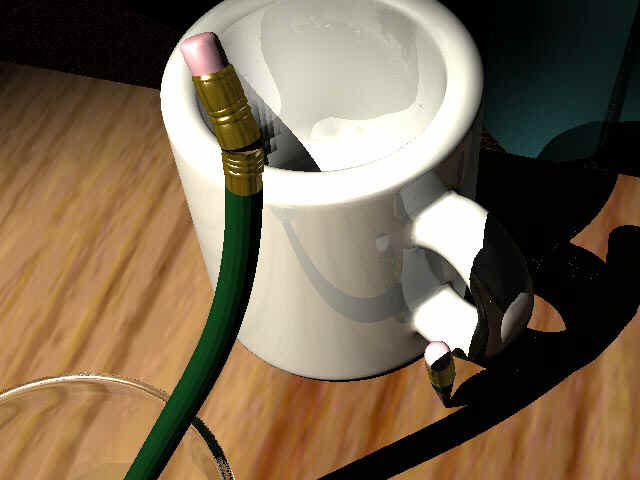|
|
|
GALLERY CONTINUED
PAGE TWENTY-ONE
So, you put together an animated short. Now what? If the exhibitors/distributors you approach mention getting a URL link to view your short, I guess you make them one. Creating the file is easy because INSPIRE includes support for so many compressed video standards, including broadband-friendly MPEG-4. "Bink" was used to convert the TGA's to their "bik" format, then "Bink" was used again to add the soundtrack, and finally, to convert the file back from "bik" to an "avi" in the MPEG-4 format (and then change the suffix by clicking on the file and changing the "avi" to "mpg.") In uncompressed form, the file was about 2.5 gigabytes long; the MPEG-4 was 6 megabytes.
The first time I mailed out a CD-R, it looked like I wouldn't get so much as an e-mail reply. I might as well have mailed it using a dumpster. But I hadn't figured out at the time how to make MPEG's, so I guess I gave the prospective buyer an "exe" that they probably couldn't use. In any case, after about a month I DID get a reply. It was a rejection letter, but that didn't make the short any worse, and it included a polite request to see future work. The next time that I sent the short to another well-known venue, it was in the form of a VHS tape. Guess what? No letter, nothing, two months later. Again, to be fair, it was "Exposure," which wanted sci-fi, and which was fairly inundated with submissions.
In the two years since trying this, the concensus among distributors seems to be to switch one's graphics card for one that allows "video out." This is pretty affordable and common, because it is the same way people use large screen TV's to play video games. The "video out" option can be cabled to a VCR, to produce a VHS tape. VHS tapes seem to be widely preferred over CD Div-x and Exe files at this time, to judge from various distributors. If the graphics card compromises INSPIRE's effectiveness, that may be a trade-off one can live with; but don't throw away the older video card, just in case.
For "autoloading" "inf" files, here is a file I use:
[autorun]
OPEN=EXPLORER.EXE .\AUTORUN.HTM
ICON=AUTORUN.HTM
The file name is "autorun.inf," it turns on Internet Explorer and opens the page "autorun.htm" OR whatever name your automatically-loading web page happens to have -- changing the names as required for folders, etc. You type and save the file in MS "Notepad" and include it on your CD-R. When the viewer puts in the CD-R, your press kit and clickable file appears. Using Internet Explorer gives your viewer the opportunity to close the page or minimize it, so there's a minimum of heartache if they want to put the CD in without examining it.
There are a couple of glitches in the short, and it needs titles and a domain name ("www.my greatideaforacompanyname.com"), but on the whole, it's a giggle. There is no excuse for not making one's titles at the same time, or even days later, and this version has been fixed in a handful of places with re-shoots of just a few frames at a time.
"STUBBY'S DREAM"

"STUBBY'S DREAM" is an 83 second 3D animated short about a pencil woken from its slumber by another pencil.
"STUBBY'S DREAM" was produced by Scott Lee Tygett using the "INSPIRE 3D" program developed by NEWTEK INC. from its award-winning LIGHTWAVE 3D program. The pencils and several other objects in the 3D animated short were modelled by Scott Lee Tygett, though some royalty-free objects included with "INSPIRE 3D" were also used. Both of the voices heard are Scott.
In addition to "INSPIRE 3D," which runs on the Intel Windows 95/98 platform, Scott Lee Tygett used Steinberg "WaveLab Lite" to edit tracks and transcribe lip synch to animate the mouths, and "Bink" from http://www.smacker.com/ , which was used for compression, previewing and compiling.
"STUBBY'S DREAM" was rendered as a series of 2500 Targa images, approximately 900 Megabytes each, for a total size of ~2.5 Gigabytes in the uncompressed "avi" format. It is made available on this CD-ROM disk in the following formats: "bink" exe, with sound, a better than MPEG-2 "clickable" file with built-in player; MPEG-4 "avi" with sound; thumbnailed Targa stills; and the "wav" soundtrack file.
"STUBBY'S DREAM" is Scott Lee Tygett's first synch-sound computer animated film. Scott received a Master's Degree from the UCLA Animation Workshop in 1994, and has collaborated on a variety of projects including co-writing commercials and co-producing shorts for "LIQUID TV." "Stubby" was the sixth in a series of animated shorts made in the course of home-study using "INSPIRE 3D."
I knew I wanted to do something with a spiritual angle, even if it had to be remotely spiritual. "Stubby" grew out of another short that I would like to get back to, which was an argument between the two ends of a pencil. In the rough version, the eraser was self-defeating and materialistic and the point was loving and productivity-oriented. One element of spiritual thinking is that eternal life exists, and I wanted to play with that using a pencil near the nub stage. Recording the lines became improvising the lines, and then revising the animation to fit them. Kind of neat.
"STUBBY'S DREAM" was written, animated and recorded in October and November, 2000. Scott Lee Tygett, Scotttygett@juno.com , 12600 Killion Street, Valley Village, CA 91607-1535 (818) 755-4517.
All contents copyrighted Scott Lee Tygett c. 2000
< BACK . . . . . . . . . . . . . . < HOME > . . . . . . . . . . . . . . NEXT >